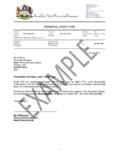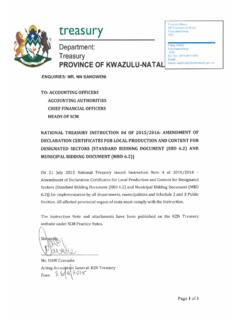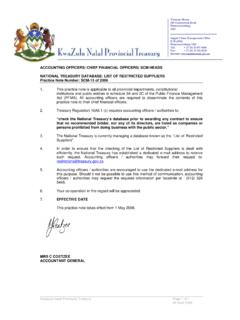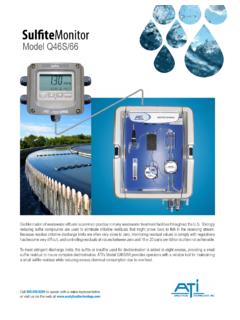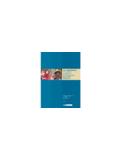Transcription of PROVINCIAL mSCOA & FINANCIAL MANAGEMENT FORUM …
1 PROVINCIAL mSCOA & FINANCIAL MANAGEMENT . FORUM . Review of useful lives and residual values Assessing impairment and reversal of impairment Presented by: Ms Kashnee Sewnarain FINANCIAL Reporting, Office of the PROVINCIAL Accountant General Date: 29th June 2015. 1. GRAP 17 PROPERTY, PLANT AND EQUIPMENT. Determining useful lives and residual values Useful life : the period over which an asset is expected to be used (available for use) by an entity Economic life : the period over which an asset is expected to be economically usable by one or more users, not limited to the municipality (actual/complete life span). Useful life may be shorter than its economic life , as MANAGEMENT may have a practice of disposing the assets after a specified time which will then imply a residual value Example: Policy to replace vehicles every 3 years (useful life ), however the vehicles may be usable for 10 years (economic life ).
2 residual value: estimated amount that would be currently obtained from the disposal of an asset, after deducting estimated costs of disposal, if the asset was already of the age and condition expected at the end of its useful life . 2. GRAP 17 PROPERTY, PLANT AND EQUIPMENT. Assessing residual values Example: A municipality has purchased an Audi on 1 July 2014 for R 400 000. In order to determine the residual value, the entity must determine the useful life of the asset. If the entity estimates the useful life to be 5 years, which is shorter than the economic life of Audis, it therefore can be assumed that the asset will have a residual value. Similar Audis that are 5 years old are currently sold for R 100 000. The municipality must then estimate the residual value of the vehicle to be R 100 000 at the end of its useful life .
3 (remember to obtain evidence supporting residual values). Note: If residual value is greater than or equal to carrying amount of asset (no depreciation is recognised until the residual value has decreased below carrying amount). 3. GRAP 17 PROPERTY, PLANT AND EQUIPMENT. GRAP 17 requires municipalities to review the useful life and residual value of an asset at least, at each reporting date (end of FINANCIAL year). If estimates differ from previous estimates, the change shall be accounted for as a Change in accounting estimate, which is in accordance with the Standard on GRAP 3 (Accounting Policies, change in accounting estimates and errors). Change is accounting estimate is Prospectively applied meaning that the change is applied from the beginning of the current reporting period going forward Review of useful lives and residual values does not mean physical inspection.
4 Municipalities are to consider factors relevant to each asset, which could impact on a change in useful life or residual value 4. GRAP 17 PROPERTY, PLANT AND EQUIPMENT. Assessing residual values Methodology should be documented on factors to be considered and evidence of review of these factors Not appropriate to reassess useful lives or residual values by taking a blanket approach per class of asset. It must be assessed with specific reference to each asset. Factors to take into consideration that may be considered in reviewing the useful life of an asset: Assets where the carrying amount is zero or close to zero, but are still in use Maintenance costs of an asset to determine whether there is a significant increase as compared to previous years Performance of the asset to determine whether a decrease/reduction in performance Municipal plans to dispose the asset or municipal plans to replace the asset Past experience in terms of holding similar assets Condition of the asset Other relevant factors 5.
5 GRAP 17 PROPERTY, PLANT AND EQUIPMENT. Assessing residual values Not all classes of assets will have residual values or the residual values may be insignificant and therefore immaterial. Assets may not be disposable after its useful life , example infrastructure assets (waste water networks, roads). 6. GRAP 17 PROPERTY, PLANT AND EQUIPMENT. Assessing residual values Example: Motor vehicle purchased at a cost of 1 July 2013 at R 120 000 (excl VAT), and is expected to be used for 5 years, with a residual value of R 15 000. As at 30 June 2015, the entity has established that currently a 5 year old motor vehicle sells for R 25 000, therefore the new residual value is estimated at this amount. Remaining useful life as at 1 July 2014 (beginning of current year) = 5 1 = 4. New depreciation = ( 120 000 25 000) /4 = R 23 750.
6 Old depreciation = ( 120 000 15 000) / 5 = R 21 000. Change in estimate = 23 750 21 000 = R 2 750 (to be disclosed in AFS). Journal entry to record change in residual value: Dr Depreciation 23 750. Cr Accumulated Depreciation 23 750. 7. GRAP 17 PROPERTY, PLANT AND EQUIPMENT. Assessing Useful life Motor vehicle purchased at a cost of 1 July 2013 at R 120 000(excl VAT), and is expected to be used for 5 years, with a residual value of R 15 000. As at 30. June 2015, the useful life of the asset has been reviewed to be 10 years from the purchase date ( remaining useful life at current reporting date is 8 years). We need to calculate depreciation from the beginning of the current reporting period (1 July 2014) and therefore we need to determine the useful life at 1. July 2014. Useful life as at 1 July 2014: Revised useful life = 10 1 (2014 year that has passed) = 9 years OR.
7 Remaining useful life = 8 + 1 ( current FINANCIAL year) = 9 years New depreciation = (120 000 15 000)/ 9 = R 11 667. Old depreciation = (120 000 15 000)/ 5 = R 21 000. Change in accounting estimate = 21 000 11 667 = R 9 333. 8. GRAP 17 PROPERTY, PLANT AND EQUIPMENT. Assessing Useful life Journal to be processed on 30 June 2015: Dr Depreciation 11 667. Cr Accumulated Depreciation 11 667. Recognition of depreciation based on revised useful life Disclosure of change in estimate covered in GRAP 3 Changes in Accounting Policies, Estimates and Errors 9. GRAP 26 AND GRAP 21 IMPAIRMENT. OF CASH GENERATING AND NON- CASH GENERATING ASSETS. 10. GRAP 21 and 26 IMPAIRMENT OF ASSETS. cash generating vs non-cash generating Cash generating assets are assets held with primary objective of generating a commercial return (positive cash flows).
8 Non-cash generating assets are assets other than cash generating assets generally primarily held for service delivery Instances may apply where a portion of the asset is used for profit making (eg. Portion of hospital is rented out as kiosk) - Consider primary purpose of holding an asset profit making (cash generating) or service delivery (non cash generating). Roads more likely to be non cash generating assets as they are mainly used in providing a service to the general public. Other assets such as substation, water reservoir and sewerage plant can be treated as cash generating, if these assets generate cash flows independently from other assets (not incidental/insignificant). 11. GRAP 21 and 26 IMPAIRMENT. Indications of impairment Indicators of impairment Non Cash Generating Asset: Demand or need for service has ceased or is about to cease eg.
9 The need for the service is no longer needed as the parties to whom the service was provided for has obtained its own asset to perform the service;. Significant long terms changes with adverse effect on the entity have taken place during the period (technological, legal, government policy changes). Demand or need for services provided by the asset has taken a significant long term decline;. Market value of the asset has declined significantly, more than what is expected from the passage of time or use. Physical damage of the asset Asset becoming idle, plans to discontinue use or restructure the operation relating to the asset, or planned disposal of asset before end of useful life ;. Construction of the asset has halted before the asset is complete or in usable condition Economic performance of the asset is or will be significantly worse than expected eg.
10 Increase in maintenance costs, lower service/output levels 12. GRAP 21 and 26 IMPAIRMENT. Indications of impairment Indicators of impairment Cash Generating Asset: Significant long term changes with adverse effect on the entity have taken place during the period (technological, legal, government policy changes). Market value of the asset has declined significantly, more than what is expected from the passage of time or use. Interest rates have increased and those increases are most likely to affect the discount rate in calculating the asset's value in use and decrease asset's recoverable amount significantly. Obsolescence or Physical damage of the asset Asset becoming idle, plans to discontinue use or restructure the operation relating to the asset, or planned disposal of asset before end of useful life ;. Economic performance of the asset is or will be significantly worse than expected eg.
